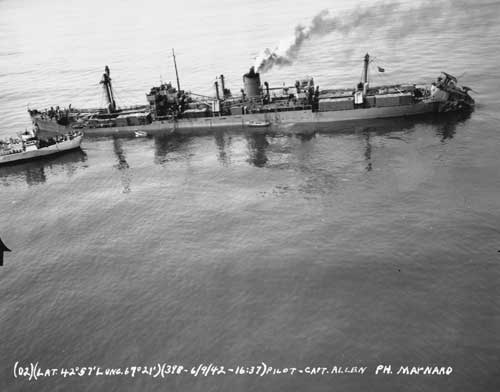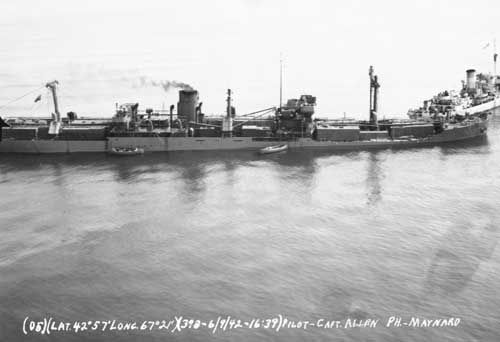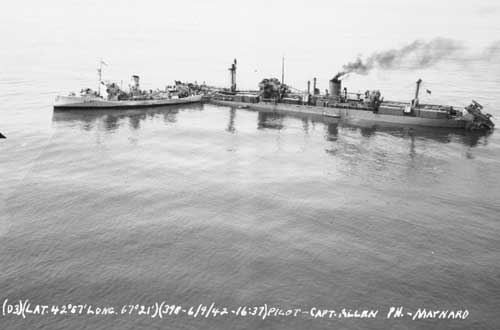| Site Map | Search Warsailors.com | |
|
M/S Kronprinsen - "Pubnico's Flour Wreck"
To Kronprinsen on the "Ships starting with K" page. The following pictures were received from T. Cooper
In the early days of World War Two there was a famous security poster, which read: "Loose Lips Sink Ships". Everything was top secret, and there was a good reason for this. Enemy submarines known as U-Boats were lurking close to our shores with the intentions of sinking Merchant ships of the Allied fleet. In those days, Evelyn M. Richardson, award-winning author of "We Keep a light" was the light keeper's wife on Bon portage Island. In her book "B-Was-For-Butter", she explains the A-B-C- codes that light keepers were instructed to observe: A- for apple, -Navigational lights are to be exhibited and fog signals and radio beacons operated normally. Of course, instruction "B" was the crucial one, meaning that enemy crafts were feared to be operating in the area and all was to be kept quiet. Because of this Canadian and United States ships "hugged" as close to shore as possible for protection. In the summer of 1942 the people of West Pubnico and surrounding areas played a part in the salvage of three Merchant ships, working for the war effort. There was the American freighter West Jaffrey, the U.S. liberty ship William MacLay and the 11,000 ton Kronprinsen (Crown Prince) known locally as "Pubnico's Flour Wreck". All these freighters were loaded with war materials on their way for Europe. There were: army trucks, jeeps, rolls of tin and brass, block busters bombs (William Maclay) ammunitions, bales of cotton, rolls of paper, egg powder in cans, big bars of pure chocolate, cigarettes with brand names like Chesterfield, Lucky Strikes, Old Gold and Phillips. There was also Mennon shaving cream, and Palmolive soap, salted Planters peanuts in tins, etc. and in the case of "Flour Wreck" much of the cargo was vitamin b enriched, "Cream of The West" flour in 140 pound bags. (There may have been other brands as well). The West Jaffrey* struck a ledge near the Mud Islands, and there it stayed until 1954 when Hurricane Edna pushed it into deeper water, it is there still. The William MacLay, which grounded on Elbow Rock near Seal Island, fared much better and was re-floated and repaired.
Perhaps the most interesting of this trio was the M.V. Kronprinsen, now known as the "Flour Wreck". The Kronprinsen, under command of its Norwegian skipper Captain Jørgens (possibly Jørgensen?), was on her maiden voyage, only forty days out of the shipyard at Glasgow, Scotland where it had been built (Kronprinsen, ex Empire Fairbairn, was completed in Apr.-1942, taken over by Nortraship on Apr. 27). This ship sailed from New York in early June 1942, as part of an American convoy bound for Britain via Halifax. At seven o'clock in the morning when the convoy was about 125 miles south west of West Pubnico, a German U-Boat attacked them. The convoy had to keep on going as the M.V. Kronprinsen stopped two vicious Nazi torpedoes. The first torpedo hit on the port side, making a gaping hole 21 feet long and eight feet high, flooding no.1 and no. 2 holds and setting part of her cargo of cotton on fire. The second torpedo tore away her rudder and propeller, flooding no. 6 hold, and collapsing her afterdeck. In spite of all this damage the tough United Nations freighter, stayed afloat, the sea was calm and it is believed that two crewmembers lost their lives in the attack. For the next 20 hours, the disabled ship floated low on the water, a sitting duck at the mercy of any sudden storms or more enemy action, fortunately neither came. When help finally arrived, it was one United States tug and two Canadian tugs from the Foundation Maritime Co., under the able command of the legendary, cigar chewing, Reginald Featherstone, "Admiral of the salvage fleet". According to old newspapers, five days later the tugs reached Pubnico, the nearest harbour safely, with the Kronprinsen, listed badly in tow, but her flag still flying bravely in the breeze. Her cargo had to be unloaded into other freighters to raise her waterline for temporary repairs. Some people from the Pubnicos were hired to help with the unloading and repairs. Sylvester d'Entremont, who later saw front line action in the theatre of war in Europe, recalls how he had helped to close the hole in the fore section of the ship. A heavy canvas was stretched over the outside of the hole while the inside was sealed using a combination of cement, and of all things, horse manure. It appeared that manure had a sealing effect, which worked well with cement. Isaire d'Entremont is now 83, and he remembers very well using a lobster boat to haul barrels of horse manure from "Le pont du marais" to the stricken ship at the mouth of the harbour. His brother Justinien was the mail driver then, using a horse and wagon. They had a good supply of "sealing" materials. About this time there was a rumor going around that the Ardnamurchan club in Argyle could be hiding enemy agents. One could not be too careful and this was investigated. The summer people with their families at the club were well known locally for many years, and the investigation was dropped. It may be safe to assume that the Americans in Argyle took this as a joke. Meanwhile, the unloading continued, much of the cargo was flour, and damaged bags were flung overboard where men in dories tried to retrieve them. According to one written account, some men were rather too daring and tried to get flour direct from the ship. (It was possible to row a dory in and out of the big hole in the side). Some officials complained about this and that also the coastal dwellers were trying to take advantage of war misfortunes by charging the outrageous wage of 60 cents per hour to work aboard the unfortunate boat. Because of the danger of being hit by falling flour bags, RCMP officers armed with water hoses kept the dories away. There were report of police officers shooting holes in the bottom of dories and the dory men whittling plugs for the bullet holes. One thing that we know for sure is that most households received wreck flour, which was much appreciated during the time of war rationing. Only the outside of the bags were wet, forming a soggy layer about half an inch thick. Inside the flour, which was sort of gray, remained in perfect condition. Elisee d'Entremont (Slu) remembers, as a boy of 16, taking his father's ox team and wagon for delivering flour to most of his neighbors. The people would lay the wet bags on the woodpile for drying, and biscuits never tasted as good as they did in the summer of 1942. After several weeks, Captain Featherstone and his crew towed the M.V. Kronprinsen to a Halifax shipyard, reaching their destination on July 24. The "flour wreck" had taken the worst that Hitler's boys could throw at it and after permanent repairs were done, lived to continue in the ferrying of vital supplies across the Atlantic once again.
Back to Kronprinsen on the "Ships starting with K" page.
|


